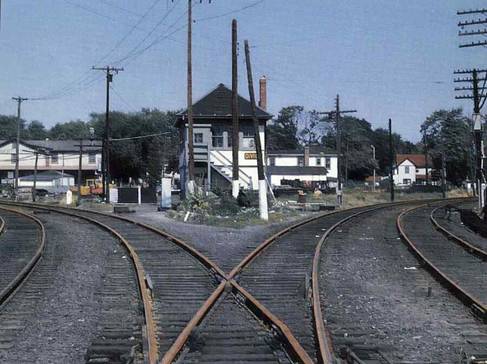|
OCTOBER 2020
|
|
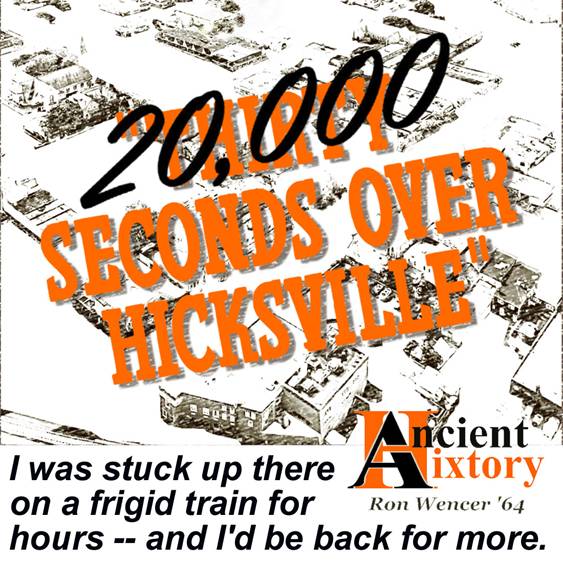
|
|
***
|
|
February
2, 1976
|
It was the 1970s, but it might as well
have been the 19th century.
A winter storm was hitting
Long Island
, and in the morning the LIRR
sent train after train of passengers westward - even though the line
was impassable. Thousands of
commuters found themselves marooned above
Hicksville
, east of the frozen switch points at DIVIDE
tower.
In the old coaches used on some of the trains, frost formed on windows.
A frigid wind blasted up through the so-called "toilets" -
open holes with seats above them, through which one could see the snow
on the track below. The
chill found its way through the many cracks into the main passenger
space. After a while, the
heating and the lights failed. Many
of the shivering commuters had no seats; they stood for hours in the
aisle, holding onto the seats' backs to steady themselves.
I was one of them.
|
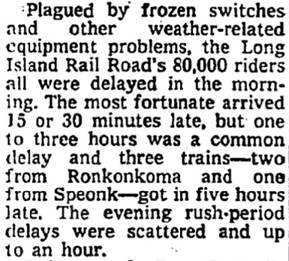
|
|
An
optimistic account of the day's events - if
you had to change trains, the second train's
delay compounded your first train's delay
New
York Times, February 3, 1976
|
|
***
|
|
The
Good Old Days
|
Nearly a century earlier, Hicksville had
acquired a paradoxical reputation among winter travelers in the
New York
area. It famously welcomed
passengers (including one Mayor of New York) who had been rescued from
snowbound trains. That was
because if a train was going to get snowed in, there was a very good
chance it would get stuck close to - but not actually in -
Hicksville
.
The storms of the era would carry snow across the
Long Island
plains that lie to the southwest, and then see fit to finally drop it
some miles east of the village. Snow
drifts would stop, and perhaps even bury, a train.
A member of the train crew then had to head out into the storm on
foot and seek help, often at
Hicksville
, because the hotels there could house winter passengers on short
notice. Once alerted,
hotels, merchants, and private citizens would send out men in sleighs to
rescue the passengers. They
brought rugs to cover shivering laps, and strong drink to warm chilly
hearts. The sleighs would
ride back over the snow, and the passengers finally would be welcomed
(at the railroad's expense) with warmth, food, and overnight lodgings.
Meanwhile, the railroad sent out crews to clear the tracks.
|
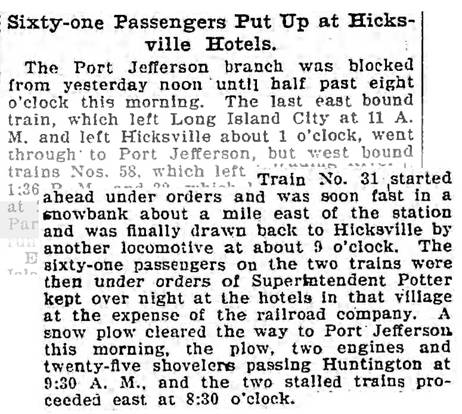
|
|
Brooklyn
Daily Eagle, 1902
|
|
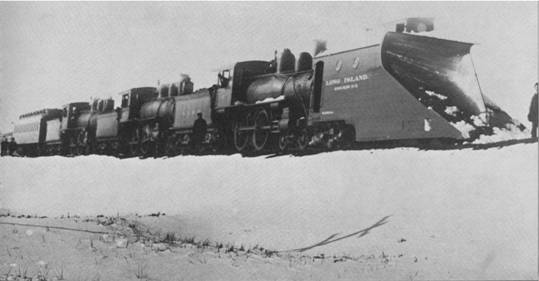
|
|
Photograph
by H.B. Fullerton, Collection of St. James General Store
as printed in Steel Rails To The Sunrise
|
By the 1970s, "big snow" winters
were rare,
Hicksville
's "hunting lodge" hotels were gone, and "snow trains" with
steam locomotives that pushed mammoth plows existed only in old movies.
The notion of passengers' being marooned out-of-reach somewhere
near
Hicksville
seemed ludicrous.
Between 1975 and 1981, I commuted by
rail between
Bethpage
and the Wall Street area. On
that morning, because an overnight ice storm had been predicted, I arose
earlier than usual, to allow myself extra time to get to work.
I went outside with Jack, our Airedale, and we discovered that
the air was cold, snow and ice were falling, the winds were very strong,
and everything was heavily coated with ice.
Jack, who understood why he had to be outside on such a horrid
morning, was no fool; he cooperated quickly, and we turned back home.
Although I considered staying home because of the weather, it was
obvious that the trains were running regularly.
I could see and hear them: we lived at the head of a T-shaped
intersection, and from my living room window I could look down the T to
the street-level crossing at the
Bethpage
station. I got dressed for
work (suit, tie, gloves, businessman's light overcoat).
By 7:00 AM I was slipping and sliding (albeit not as suavely as
Little Richard would have) down to
Stewart Avenue
.
The train would be crowded; bad road conditions would divert automobile
commuters to the railroad. As
always, it arrived fashionably late (about five minutes behind
schedule). Despite the
crowding, there were a few seats free, and I happened to get one.
The diesel's horn tooted twice, and we began to move.
I settled in, and let the train rock me back and forth.
I gazed though the smeared windows, watching the snow swirl as we
accelerated past Grumman. It
was not a bad start for what had looked like a daunting day; things were
unfolding as they should.
That particular train was not due to stop until we reached Jamaica, so
in a little while, in the 30 or so seconds from the time we crossed over
Old Country Road until we had passed the station, I would get a glimpse
of ice-coated Hicksville.
Just past
New South Road
, however, the train began to slow, more and more, until it was scarcely
moving. I was sitting on
left side of the train. Though
I was adjacent to the aisle, and the snow was falling heavily, I still
could see well enough through the window to make out the old LILCO
complex ahead. The train
very slowly followed the track up the embankment, its wheels groaning,
and we stopped. Because we
had entered the start of a curve, we were tilted at an angle, and it
took effort not to lean against the person sitting on one's left.
The people standing in the aisle were having a worse time,
leaning despite themselves against those who sat nearby.
Time passed; we stayed like that.
This was an "old train" (see Two
Worlds, below, for an explanation).
There were no PA speakers, which at least saved us the task of
trying to decipher garbled announcements.
The car was silent, save for the words "Oh, excuse me," which
were uttered repeatedly, whenever people standing on the tilted floor
shifted position, and accidentally leaned into (or stepped on the toes
of) someone else. Although I
had been seated, as the delay persisted, I surrendered my seat to a
young woman who was standing nearby.
Her stylish spike-heeled boots (Ideal
footwear for an ice storm, no?) were clearly unmanageable on the
slanted floor.
|
***
|
|
Hicksville
(somewhere on the 2nd Floor), about 8:25 AM
|
The door at the front end of the coach
was yanked open, and in came a snow-covered acquaintance of mine, also
named Ron.
I knew that his customary morning train would have departed
Bethpage
at about 6:40 AM; he should not have been on this train.
Before he continued down to the other end of the car, he paused,
and we talked briefly. This
is the gist of what he said:
Overnight, ice had fallen so rapidly that the melting devices fitted to
the elevated tracks at DIVIDE tower could not keep the track switches
clear. The spot where the
Port Jefferson and
Ronkonkoma
lines converged had become impassably solid with ice.
In the early morning, optimistic that the ice blockage would be
broken quickly by track workers, the LIRR had sent all the normal trains
for those two lines towards the impasse.
Now, hours later, the switch points were still frozen solid.
Ron had left
Bethpage
early, more than an hour ahead of me.
After being stuck so long, he had lost patience - so he walked
to the end of the car in which he had been riding, went out to the
vestibule, opened the steps, and climbed down to track level to look
around. There, he saw a line
of perhaps six trains, end-to-end, extending back towards Bethpage.
He also looked across toward the Port Jefferson branch, where he
saw trains similarly backed up.
By
talking to the train crews (who seemed not to mind that a passenger was
walking around up on the elevated tracks), he learned that the first
train in this impromptu "conga line" had run out of fuel for heating
(again, see Two Worlds,
below, for an explanation), so that train had been connected to the
train behind it, which soon followed suit.
Now, neither of the two trains had any heat.
And so, Ron was squeezing his way along the length of train after train
(and thereby getting glared at a lot).
Between trains, he would climb down to track level, and walk in
the storm until he could climb up onto the next.
When he got past the last train in the line, the track would be
back down on ground level, and he would find a way to walk home.
|
Note:
This was 1976, so:
There was no Internet; there were no cell phones.
There was no way to find out what lay ahead, or to call
your workplace, or to call home.
The track to Bethpage was not yet electrified.
Ron ran no risk of being electrocuted.
|
For a long while, nothing much
happened. The snow and ice
got noticeably lighter than before, and the gusts probably no longer
topped 30 mph, but the old coach in which I stood was rife with icy
drafts. Cold air even blew
up from the floor wherever the passenger seats were attached to it.
The train suddenly lurched forward, coasted a while, and stopped again.
A few people gave half-hearted cheers of sarcasm.
A train ahead of us must have made it through to Hicksville!
I was encouraged to think that we might soon get our turn.
We were closer now; I could see part of Marie Street, including
the side of the Fire House. Amazingly,
I also saw a long ladder that angled up to the overhead track structure.
Evidently, Hicksville FD had positioned an aerial truck (I could
not see the truck itself because of buildings were in the way) and
deployed its ladder.
Seeing the ladder, people began to talk.
A few thought that we all - the thousands of us who were stuck
up there - would be evacuated down the ladder.
Some optimist thought that the Red Cross was going to give us hot
coffee and doughnuts, by having firemen carry them up the ladder for us
(Sorry, I wanted a coffee with TWO sugars - would you mind going down
again and getting me one?). I
assumed that the ladder was strictly an emergency provision, in-place
should a stressed passenger suffer, say, a stroke or heart attack.
Given how isolated we were, I was grateful that someone was
thinking about us at all.
|
***
|
|
Hicksville
Station Platform, about 10:15 AM
|
A second lurch forward brought us into
Hicksville. Eager to escape,
or just to stand on level ground - well, level concrete - for a
change, many people rushed out of the train.
It headed off to Queens. I
decided to go home instead of work.
Except that, given the icy roads and
the icy everything else, I didn't want to wait on line at a phone
booth, and then arrange for somebody to risk driving me back home.
The best thing would be to simply take the next train back to
Bethpage, and walk the one block back to my house.
I asked when the next train east to Bethpage was due.
"Next train heading east?
There are none. All
the trains we have are either stuck out there, waiting to head back to
Jamaica, or they're on their way as we speak, so that they can get new
crews and be refueled before they get put back into service.
There won't be any eastbound trains for a few hours."
And so, I instead waited for the next train heading west, to the City.
It took a while, but when it arrived it was warm (it had come
from Huntington, where the line was electrified; the cars were the
then-new new silver and blue M-1s).
Everybody crowded in. It
departed at around 11:00 AM, and it made lots of stops.
Even when it didn't, the train in front of us did, so we
stopped between all the stations we had passed.
It was a slow journey to Jamaica.
The "change at Jamaica" madness was more chaotic than usual, but I
quickly found a connecting train to Atlantic Avenue (Brooklyn), from
which I would take the subway into Manhattan.
Again, the tracks ahead of us were congested; the trip to
Brooklyn was extremely slow.
|
***
|
|
Chase
Manhattan Headquarters, 1:03 PM to 2:35 PM
(including
my 42 minute workday)
|
In comparison, the subway moved like a
skyrocket. I arrived at my
desk just after 1:00 PM, and I gave my boss a quick summary of my
morning's travels. He
laughed (The nerve of some people!) and told me to turn around, go back
home, and rest. I then
called my wife, in case she was worried.
"I'm at work," I announced, for some reason expecting to
hear a sigh of great relief. Oblivious
to what I'd been going though, she simply answered, "So?"
To kill a little time (and the let the LIRR
get ready), I had lunch at Chase. I
did a small amount of work, and then I set out on my return Odyssey.
I subwayed to the LIRR, and I did not have long to wait for a train to Hicksville, one
which was scheduled to connect with a train to Bethpage.
|
***
|
|
Hicksville
Station Platform, about 5:15 PM
(7
hours after my morning arrival)
|
The train was not crowded, and the
trip went smoothly. To my
shock, my Bethpage connection was waiting.
I'd be home in Bethpage in less than 15 minutes!
Or not.
The train sat there, nearly empty. As
expected, the equipment was decrepit (yet again, see Two Worlds, below), but this time the heat and lights worked, which
made a big difference. I
settled in by a window and a warm radiator, and I watched my old
hometown appear to do absolutely nothing for a while.
The silent waiting dragged on. On
the platform, the train crew appeared to run out of things to discuss.
A Huntington-bound silver train stopped on the other track,
discharged some passengers, and went on its way.
Some time later, another train did the same thing.
After I'd sat there for over an hour, a diesel train arrived on
the other track, and it stayed there.
A Trainman came into our car and told us that we should get on
the newly arrived train.
Ever-obedient little lemmings, we did as we were told.
Again, nothing happened for quite some time.
Finally the same Trainman, remarkably unembarrassed, came in, and
he told us to return to the first train, as plans had changed
(Plans? The possibility that
there were plans had not occurred to me).
All of us went back to the first train, and we began to re-warm
our old favorite seats. Now
empty again, the second diesel train headed west, towards Jamaica.
Eventually, another "Silver Snail" slid into Hicksville.
It disgorged a lot of desperate-looking passengers, who ran
frantically to our train, as if their hurrying mattered.
We waited further, and then we abruptly stopped waiting - with
no announcement, the train departed.
I got off at Bethpage, walked the one icy block to my home, and
got in the door just after 8:00 PM.
To recap, my morning commute had taken
around 6 hours. My evening
commute had taken only a little less.
In between, I had worked fewer than 45 minutes at my job.
In total, I had spent more than 5½ hours stuck over Hicksville.
Much of that time was spent under truly deplorable conditions, confined
on elevated track in a very drafty old railroad coach with no heat,
water, or acceptable rest room. Why
were things on the LIRR so
bad?
Let's find out.
As its LIRR
tower proclaims, Hicksville is the point at which the central line of
the railroad divides in two. "Port
Jefferson" and "Ronkonkoma" trains (to use the common, if
unofficial, names for their respective branches) are on separate tracks
east of DIVIDE tower, but they share the Main Line west of it.
The tale of the storm highlights the
"Have / Have Not"
differences which existed in the 1970s between these branches.
In those years, if you lived in, say, Huntington, you were
blessed with electrification and the new trains that came with it.
The fact that the M1 equipment would develop some very real operational problems does
not diminish the fact that, in general, electrification had
substantially improved the quality of passenger service on the line.
If you were stuck in an M1 car during the Ground Hog Day storm of 1976, you still had heat,
air circulated by a modern ventilation system, working restrooms, and if
you were seated, a comfortable seat.
It is understandable that financial resources were not available for the
railroad to improve and electrify Ronkonkoma service at the same time as
Port Jefferson service. What
is not understandable, however, is that the quality of commuter service
on the Ronkonkoma branch had been permitted to substantially deteriorate
in the years leading up to that time, and that adequate steps were not
taken to maintain minimum service standards, even when things became
dire.
In the early 1970s, it was still true
that much of the diesel passenger car fleet had begun its service as
part of the steam passenger fleet. A
small part of it had been built in the 1960s; and a large part of it
dated from the 1950s. Many
of these cars had to some degree been upgraded (e.g., acrylic windows
been replaced the original safety glass, to better resist vandalism).
The remainder of the fleet - and until 1974, this remainder was
a significant minority of it - dated from the 1930s and the late
1920s. These cars had gone
through rebuilding programs some years before, but the oldest among them
remained primitive, especially in terms of restroom facilities.
Things came to a head (no pun
intended) in 1974, when part of a 1920s coach suffered a structural
failure, causing a minor crash. Damage
was not serious, but the implications were - all of the remaining
1920s coaches had to be withdrawn from service immediately and scrapped.
The railroad had to scramble, desperately trying to pick up surplus
commuter coaches from other railroads, but good coaches were not easy to
come by. If it found a car
that had seats, would not suffer structural failure, would roll safely
on the track, and had operating brakes, it was worth acquiring, and it
was put into service as soon as possible.
Note that compatibility with LIRR
electrical standards for power to be used for lighting, fans, and
heating were not mandatory. Thus,
on dark winter evenings in 1976, I often rode home in a coach that had
neither lights nor heat. For
a while, the regular Trainman wore a miner's helmet, with a light that
let him see the tickets he was punching (he later switched to carrying a
flashlight).
The above explains why some cars never
had heat. But why, during
the ice storm, would an entire train of coaches lose power all at once?
Railroads use different methods to generate "hotel power" (i.e.,
electricity appropriate for lighting, heat, and air conditioning) for
passengers cars. In the
1970s, most commuter railroads in North America, including the LIRR,
took the same approach, which was easily recognizable.
From the outside, their commuter trains appeared to have two
unmatched diesel locomotives, one at each end.
|
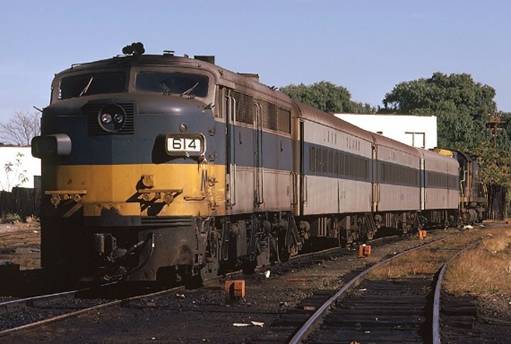
|
|
LIRR
Power Car 614, purchased as a used Alco FA-2 locomotive
from the Burlington Northern Railroad; the newer diesel engine
at
the other end of the train actually pushes or pulls it.
https://www.pinterest.ca/pin/659707045388146893/
©
George W. Hamlin
|
In reality, one of the apparent
locomotives no longer functioned as one.
Typically, it was very old, and it had been acquired second- or
third-hand after decades of service.
It then was rebuilt into something called a "Power Car."
An engineer could drive a train from a Power Car, because its
controls were connected electronically to the real locomotive at the
train's other end. The
Power Car's other purpose was to generate hotel power for the train.
The old combustion engine inside it was no longer connected to
its wheels, so it could not move the train (or even the Power Car
itself); it simply generated electricity.
So, what went wrong on February 2? The
trains for the morning rush hour had spent the night out east.
Their Power Cars had only enough fuel in their tanks to handle
their morning rush-hour assignments; after that, they would be refueled
in Queens. But when a
90-minute run from, say, Ronkonkoma to Hunterspoint turned into a 5-hour
run, they ran out of fuel. The
real locomotives had plenty of fuel to move the trains - but they did
not have the generators needed to create hotel power.
Poof! No more heating
and lights.
So, many, many commuters suffered on
the day of the ice storm, but some of those who lived on the diesel
branches suffered more.
Although I normally feel an attachment for the place in which I grew up,
I do not have many fond memories about having to hover over Hicksville
for all those cold hours.
And to close....
Imagine being able to tell all your family and friends that you
had got your name in the newspaper!
|
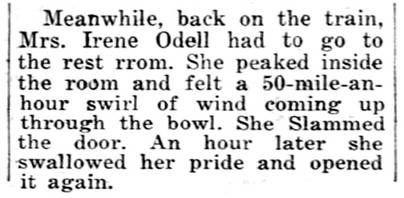
|
|
New York Daily News, February 3, 1976
|
|
*****
|
Ciao!
|




